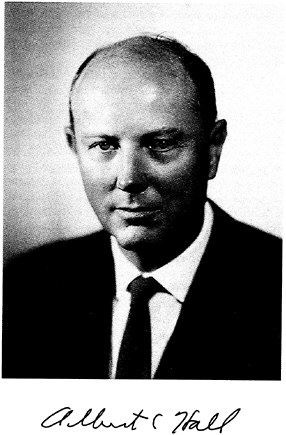ALBERT C. HALL
1914–1992
BY LAURENCE J. ADAMS
ALBERT C. HALL, a pioneer in the field of automatic control and servomechanisms, died on September 14, 1992, in Washington, D.C. after a long illness.
Dr. Hall received his B.S. degree from Texas A&M College in 1936. He then went to the Massachusetts Institute of Technology (MIT), where he continued his studies and worked as an instructor in the Electrical Engineering Department. He received his M.S. degree in electrical engineering in 1938 and his Ph.D. degree in electrical engineering in 1943. His doctorate thesis is part of the foundation of automatic control theory.
He continued his stay at MIT as an associate professor. During World War II, as a member of the MIT faculty and research staff, he led the development of the control system for the U.S. Navy's first operational guided missile. After the war, at the request of the navy, he founded and became the first director of the Dynamic Analysis and Control Laboratory, which was dedicated to the development of guided missile control systems. He continued in this activity until 1950 when he joined the Bendix Aviation Corporation as associate director of their research labs.
His creative genius continued to thrive while he was at Bendix. He was responsible for the work that led to the country's first computer-controlled production tool. This tool, a profiling mill, was in operation for many years after its installation
at Martin Marietta's Baltimore aerospace factory in 1957. During his years at Bendix he rose to the position of general manager.
In 1958 Dr. Hall left Bendix and joined the Martin Marietta Corporation where he became director of engineering for the Denver Division. Martin Marietta's Denver Division was, at that time, dedicated solely to the accelerated development of the Titan I intercontinental ballistic missile. This was during the so-called missile gap between the United States and the Soviet Union. The technical development of Titan I was successfully completed on schedule under Dr. Hall's leadership. However, he perceived that the tremendous complexity of the cryogenically fueled Titan I would result in very difficult and intensive operational maintenance activity.
Dr. Hall took the lead in proposing a much simplified system using storable propellants, inertial guidance to replace radio guidance, and launch directly from the underground storage silo, thus eliminating the need for the complex elevator system of Titan I.
These improvements and numerous other simplifications were incorporated into a proposed new vehicle named Titan II. He was joined in his campaign for this new configuration by Will Carlson, the senior Ramo Woolridge Corporation manager and technologist assigned to the Titan program. The U.S. Air Force subsequently accepted the idea, and the development of the Titan II system was initiated. This system turned out to be as good as Dr. Hall had projected, and more than one hundred Titan II's remained in the Air Force's operational inventory for more than twenty-five years. They are currently being converted into space launch vehicles, and several have been launched with 100 percent mission success. The Titan family is now up to Titan IV, and the basic core of these giant space launch systems uses essentially the same technology proposed by Dr. Hall in 1959.
Dr. Hall became vice-president of engineering for the Martin Marietta Corporation in 1960 and vice-president, general manager of the Space Systems Division in Baltimore in 1962. In this latter position, he organized and led the corporation's efforts on the Gemini Launch Vehicle, a system that used the basic
Titan II as its key element. This system enjoyed 100 percent mission success on its twelve flights, all manned by National Aeronautics and Space Administration (NASA) astronauts.
In 1963 Dr. Hall departed Martin Marietta for his first tour as a member of the United States government defense technology team as deputy for space technology, Office of the Director, Defense Research and Engineering. In this position, he was instrumental in promoting high reliability and lower cost space systems and launch vehicles for the nation's defense space systems.
In 1965 Dr. Hall returned to Martin Marietta, where he led its engineering and research and development activities. In 1971 he again served in the U.S. Department of Defense, this time as the first assistant secretary of defense for intelligence. Dr. Hall's contributions in this position have gone largely unheralded because of security requirements. However, this period was at the height of the cold war, and acquiring intelligence about the Soviet Union's military activities was of the highest priority. The application of superior technology to the systems of the United States was very ably executed by Dr. Hall.
Upon completion of his tour as assistant secretary of defense in 1976, Dr. Hall returned to the private sector as a consultant in technical management and technology. During this period, he established a close relationship with BDM Corporation and was a close adviser during the corporation's period of rapid growth. He continued as a private consultant through the 1980s when failing health—of first his wife and then himself—required that he curtail his professional activities.
Dr. Hall is the author of numerous technical publications and broad policy statements, which have made strong contributions to our society. His numerous voluntary activities either as a member or as chairman of important government advisory committees multiplied his contributions. He served the Defense Intellegence Agency's Scientific Advisory Committee; numerous Defense Science Board studies, panels, and task forces; and military service advisory groups; and many other important advisory roles.
His contributions have been recognized with numerous honors and awards. They include several from various government agencies and from technical societies.
Dr. Hall will, most assuredly, be remembered for his numerous technical achievements and contributions. He will also be remembered for his friendship and warm sense of humor. However, his absolute sense of integrity is the characteristic for which he stands out. All of his actions were guided by this overriding trait.







